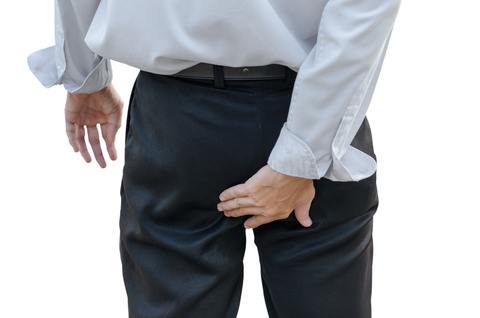Anal abscess – also referred to as perianal abscess, rectal abscess, or perirectal abscess depending on that location – is a collection of pus developed near the anal area within the anal canal furrows called anal synopsis.[1]

When does Anal Abscess Happen?
It is caused by the buildup of typical bacteria in exposed or imperiled tissues. Though the body tries hard to control the infection, eventually, the white blood cells are defeated and killed in the battle. Then the bodily fluid gets accumulated in the tissue near the anus area and forms a sack of pus.[2]
More than half of the patients who suffered from an anal abscess will eventually develop another complicated condition-fistula. Basically, it is a small tunnel that makes up a weird connection between the skin and the area of the abscess.[3]
Anal abscess or perianal abscess can develop near or within the anus area. Then eventually, it goes much further up in the rectum. Though there is no apparent reason for such occurrence, it is commonly associated with gastrointestinal disease, immune suppression, bowel irregularities, and often certain medications.[4]
What are the causes of anal abscesses?
The majority of anal abscess occurs due to the blockage of the anal area located around the anus.[5] Sexually Transmitted infectious or even infected anal fissure is another reason for anal abscesses. However, some other risk factors include:
- Inflammatory bowel diseases (IDB) like ulcerative colitis, Crohn’s diseases.
- Diabetes
- HIV or any other form of immune suppression.
- Anal sex increases the chances of anal abscesses (for both women and men).
- Chronic constipation or diarrhea.
- Chemotherapy.
- Use of medication prednisone or other steroid drugs.
- Pelvic inflammatory disease.
- Hidradenitis suppurativa- a rare skin condition.
What are the symptoms of perianal abscesses?
The most common symptom of the perianal abscess is a dull, throbbing, constant pain in the anal or rectum area and a red, swollen bump near the anus that may be sore to touch.[6]
At times the perianal abscess cannot be seen or felt by your healthcare provider and requires some additional test or diagnosis to find it out.[7]
However, the other common symptoms of an anal abscess include:
● Constipation
● Rectal discharge or bleeding
● Irritation around the anus area accompanied by redness, swelling, and tenderness
● Pus oozing out.
● Soreness during bowel movements.
Increasing and constant pain that worsens while sitting or during movements.
● Deeper anal abscesses show symptoms like:
● Fever
● Chills
● Malaise
Anal abscesses can also occur deeper in the rectum area and may result in pain and discomfort in the abdominal area. In toddlers, the signs are not visible other than the sign of pain and discomfort.[8]
What is the diagnosis of Perianal abscess?
Anal abscess or perianal abscesses can often be identified by studying the medical history of the patient and by conducting a physical exam. The doctor checks the pain, redness, and swelling in the anal area and checks for characteristic nodules.
In case the abscess roots into the anal canal, your physician will advise performing an endoscopy using light, flexible motion to get a better view and understanding about the abscess.[9]
Sometimes the abscess may be deeper than, and the doctor can order MRI, computed tomography (CT) scan, or the transrectal ultrasound (TRUS) to get a better look and deep look.[10]
At the time of the physical examination, the doctor will try to understand whether the mass is the cause of abscess or hemorrhoids. The symptoms will help to differentiate these two conditions. For example: If it’s an abscess, the pain will worsen over time, and the body won’t respond to any type of hemorrhoid treatment.
But for some patients, extra screening may be required to test for:
● Sexually transmitted infections
● Diverticular disease
● Rectal cancer
● Inflammatory bowel disease
Treatment for perianal abscess
Perianal abscess or Anorectal abscesses doesn’t go away on its own, and antibiotic therapy doesn’t help to resolve it either.[11] Generally, quick and small surgical drainage is required before the abscess becomes severe and starts erupting. In the case of casual anal abscesses, the doctor can easily drain it without any hospitalization just by using a local anesthetic.[12]
But if the abscess is large and deep and severe, then it might require a short hospital stay, and a short and quick operation will be conducted under the supervision of an anesthesiologist.[13]
The doctors numb the area using medicine and anesthesia and drain the pus from the infected area. It takes around 30 minutes for the surgery to be completed. Then the pus drained from the area is exported to the laboratory to examine the causal bacterium. If the anal abscess is left untreated, the conditions worsen, and it develops into painful anal fistulas.
As per the American Society of Colon and Rectal Surgeons (ASCRS), more than half of the people who suffered from a perianal abscess will develop an anal fistula, eventually. After the procedure is completed, patients are advised to take medications to relieve the pain. Those with diabetes or with decreased immunity are suggested antibiotics.
Typically fistula generally develops after 4-6 weeks or months or even years and requires a separate procedure that can be performed on the patient. However, sometimes fistula surgery is also performed simultaneously as the abscess surgery that demands a short hospital stay.[14]
Sometimes in case of extremely large Anal abscesses, severe surgery is required, and a catheter is used to drain the puss completely and to be the left open for it to heal and doesn’t require any stitches.
After the surgery, the doctor advises to soak the affected area in warm water (sitz) at least 3 to 4 times a day and recommends a stool softener to ease bowel movements’ discomfort. Sitting on the warm water helps to reduce swelling and allow more drainage of the abscess.
People suffering from extreme cases of perianal abscesses are advised to use mini pads or gauge pads. This helps to keep the area clean to prevent or stop the drainage from staining the clothes.[15]
What are the ways to prevent perianal abscesses?
Well, there isn’t much known about the ways to prevent perianal abscesses, but there are some precautionary steps that you can follow :
- Use protection against SIT’s and prompt treatment is necessary in case of any infection.[16]
- Use condoms, especially during anal sex, which is one of the reasons for anal abscess for both men and women.
- Both children and adults should maintain cleanliness and good hygiene around the anal area.
Though anal abscess can cause various complications, they are treatable. Read the risk and understand them so that you can closely manage your health conditions that may increase the risk. Anytime you notice any such symptoms, you should visit your doctor to get the treatment and prevent it from worsening.[17]
Bottom line
Anal abscess or perianal abscess is painful and requires surgery but they not dangerous conditions unless left untreated.[18] If you’re suffering from an anal abscess or perianal abscess, kindly visit the doctor or a medical practitioner and take the necessary steps to prevent such conditions. After all, it’s your health, and you should be responsible for treating it the right way.
[1] https://www.ncbi.nlm.nih.gov/books/NBK459167/
[2] Sahnan K, Adegbola SO, Tozer PJ, Watfah J, Phillips RK. Perianal abscess. BMJ. 2017 Feb 21;356:j475. [PubMed]
[3] Deen-Molenaar CH, Jordanov T, Felt-Bersma RJ. Intersphincteric infection due to an anal fissure. Int J Colorectal Dis. 2016 Mar;31(3):727-8. [PubMed]
[4] Ommer A, Herold A, Berg E, Fürst A, Sailer M, Schiedeck T. German S3 guideline: anal abscess. Int J Colorectal Dis. 2012 Jun;27(6):831-7. [PubMed]
[5] https://www.ncbi.nlm.nih.gov/books/NBK6943/
[6] https://www.ncbi.nlm.nih.gov/books/NBK507895/
[7] Brook I. The role of anaerobic bacteria in cutaneous and soft tissue abscesses and infected cysts. Anaerobe. 2007 Oct-Dec;13(5-6):171-7. [PubMed]
[8] https://www.ncbi.nlm.nih.gov/pmc/articles/PMC3140329/
[9] Nelson R L. Anorectal abscess fistula: what do we know? Surg Clin North Am. 2002;82(6):1139–1151. v–vi. [PubMed] [Google Scholar]
[10] Chandwani D, Shih R, Cochrane D. Bedside emergency ultrasonography in the evaluation of a perirectal abscess. Am J Emerg Med. 2004 Jul;22(4):315. [PubMed]
[11] https://www.ncbi.nlm.nih.gov/pmc/articles/PMC2780182/
[12] Sofic A, Beslic S, Sehovic N, Caluk J, Sofic D. MRI in evaluation of perianal fistulae. Radiol Oncol. 2010 Dec;44(4):220-7. [PMC free article] [PubMed]
[13] Khati NJ, Sondel Lewis N, Frazier AA, Obias V, Zeman RK, Hill MC. CT of acute perianal abscesses and infected fistulae: a pictorial essay. Emerg Radiol. 2015 Jun;22(3):329-35. [PubMed]
[14] https://pubmed.ncbi.nlm.nih.gov/24280399/
[15] Wright WF. Infectious Diseases Perspective of Anorectal Abscess and Fistula-in-ano Disease. Am. J. Med. Sci. 2016 Apr;351(4):427-34. [PubMed]
[16] https://pubmed.ncbi.nlm.nih.gov/505265/
[17] Xu RW, Tan KK, Chong CS. Bacteriological study in perianal abscess is not useful and not cost-effective. ANZ J Surg. 2016 Oct;86(10):782-784. [PubMed]

